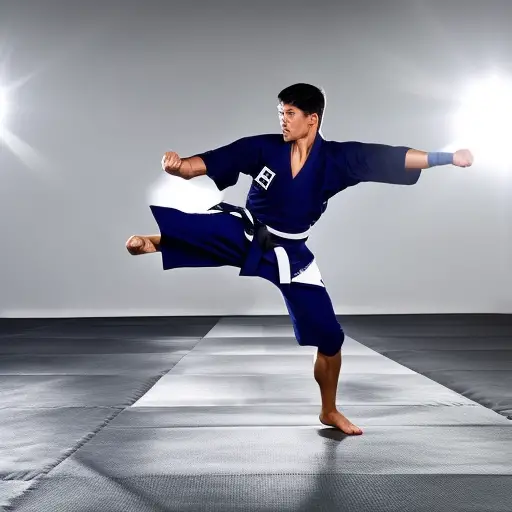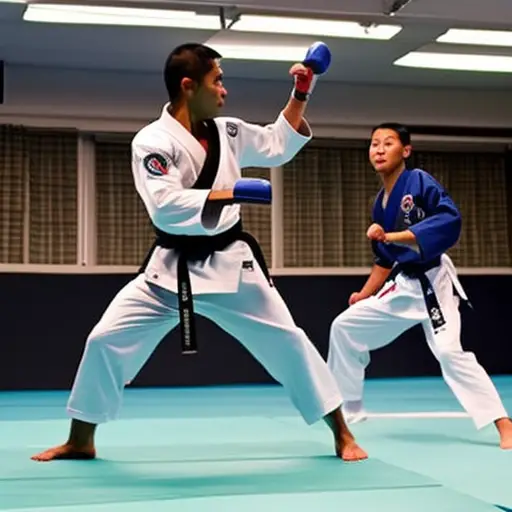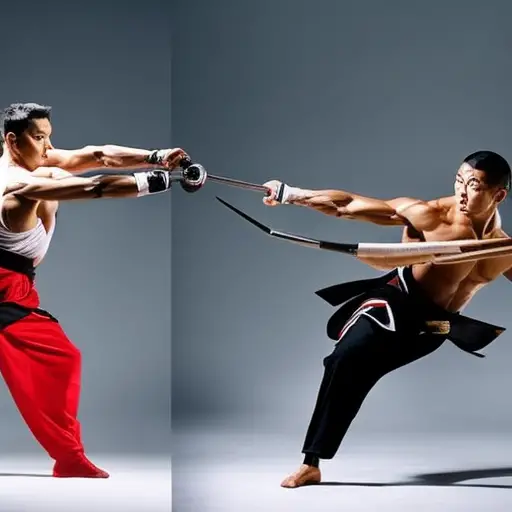Cross-Training Ideas for Taekwondo Practitioners

In the pursuit of mastery, the wise taekwondo practitioner understands the value of versatility and adaptability. By embracing cross-training, one can enhance their physical prowess, mental resilience, and overall performance.
This article offers a curated selection of cross-training ideas specifically tailored for taekwondo practitioners. From strength training exercises to yoga and pilates, plyometrics to Olympic weightlifting, each method aims to diversify and optimize training regimens.
Prepare to embark on a transformative journey of holistic development and unlock your untapped potential in the world of taekwondo.
Strength Training Exercises
The article explores various strength training exercises that can benefit taekwondo practitioners in enhancing their overall performance and physical capabilities. Incorporating weightlifting exercises and resistance training techniques into a taekwondo training regimen can lead to significant improvements in strength, power, and endurance.
One of the most effective weightlifting exercises for taekwondo practitioners is the squat. Squats target the muscles of the lower body, including the quadriceps, hamstrings, and glutes. By performing squats with proper form and progressively increasing the weight, taekwondo practitioners can develop strong and explosive leg muscles, which are crucial for executing powerful kicks and maintaining stability during sparring.
Another important weightlifting exercise is the deadlift. The deadlift primarily targets the muscles of the posterior chain, including the lower back, glutes, and hamstrings. Developing strength in these muscles is essential for generating explosive power during kicks and maintaining proper posture and balance during taekwondo techniques.
In addition to weightlifting exercises, incorporating resistance training techniques such as plyometrics and bodyweight exercises can further enhance a taekwondo practitioner’s strength and power. Plyometric exercises, such as box jumps and medicine ball throws, can improve explosiveness and speed, while bodyweight exercises like push-ups and pull-ups can enhance upper body strength and core stability.
Cardiovascular Conditioning
Cardiovascular conditioning is a vital aspect of training for taekwondo practitioners. It enhances endurance, stamina, and overall performance. High-Intensity Interval Training (HIIT) is an effective method to improve cardiovascular fitness. It involves short bursts of intense exercise followed by brief recovery periods.
Additionally, endurance-focused circuit workouts can be incorporated. These workouts target different muscle groups and maintain an elevated heart rate throughout the session.
High-Intensity Interval Training
Effective cardiovascular conditioning through high-intensity interval training is essential for enhancing performance in Taekwondo. High-intensity interval training (HIIT) involves short bursts of intense exercise followed by brief recovery periods. This type of training improves cardiovascular endurance, anaerobic capacity, and overall fitness levels. Tabata training is a popular HIIT method that consists of 20 seconds of intense exercise followed by 10 seconds of rest, repeated for a total of 8 rounds. Incorporating agility drills into HIIT workouts can further enhance a Taekwondo practitioner’s performance by improving speed, coordination, and footwork. Agility drills such as ladder drills, cone drills, and shuttle runs can be incorporated into HIIT sessions to simulate the quick movements and changes in direction required in Taekwondo. By incorporating high-intensity interval training and agility drills into their training regimen, Taekwondo practitioners can improve their cardiovascular fitness and overall performance in the sport.
| HIIT Benefits | Agility Drills |
|---|---|
| – Improves cardiovascular endurance | – Enhances speed and quickness |
| – Increases anaerobic capacity | – Improves coordination |
| – Boosts overall fitness levels | – Enhances footwork |
| – Simulates the demands of Taekwondo | – Improves reaction time |
Endurance-Focused Circuit Workouts
Endurance-focused circuit workouts provide a comprehensive and versatile approach to improving cardiovascular conditioning in Taekwondo practitioners. By incorporating circuit training variations and endurance building techniques into their training regimen, athletes can enhance their stamina, endurance, and overall performance in the sport.
These workouts typically involve performing a series of exercises with minimal rest in between, thereby challenging the cardiovascular system and promoting greater endurance.
To maximize the benefits, practitioners can incorporate exercises that target different muscle groups and movements commonly used in Taekwondo, such as kicks, punches, and agility drills. Additionally, incorporating interval training and plyometric exercises can further enhance cardiovascular conditioning and muscular endurance.
Flexibility and Stretching Techniques
Enhancing the range of motion is crucial for taekwondo practitioners, requiring effective flexibility and stretching techniques. To improve flexibility and prevent injuries, taekwondo athletes should incorporate dynamic warm-ups and foam rolling techniques into their training routines. Here are some key points to consider:
-
Dynamic warm-ups: Before engaging in any intense physical activity, taekwondo practitioners should perform dynamic warm-up exercises. These exercises involve active movements that mimic the actions of the sport, such as high knees, leg swings, and arm circles. Dynamic warm-ups increase blood flow to the muscles, improve joint mobility, and prepare the body for the upcoming training session.
-
Foam rolling techniques: Foam rolling is a self-myofascial release technique that helps to alleviate muscle tightness and improve flexibility. By using a foam roller, taekwondo practitioners can target specific muscle groups and apply pressure to release tension and knots. Foam rolling before and after training sessions can enhance overall flexibility and reduce muscle soreness.
-
Stretching exercises: Incorporating static stretching into a taekwondo training routine can help increase flexibility. Holding stretches for 15 to 30 seconds can improve muscle elasticity and range of motion. It is essential to focus on all major muscle groups, including the legs, hips, back, and shoulders, to maintain balance and prevent muscle imbalances or injuries.
-
Regular practice: Flexibility is not achieved overnight. Consistency is key when it comes to flexibility training. Taekwondo practitioners should make stretching and flexibility exercises a regular part of their training routine to see long-term improvements.
Martial Arts Cross-Training
When it comes to martial arts training, cross-training offers numerous benefits for practitioners of Taekwondo. By incorporating different martial arts into their training regimen, Taekwondo practitioners can enhance their overall skills, improve their physical fitness, and gain a deeper understanding of various fighting techniques.
Some recommended martial arts for cross-training include:
- Brazilian Jiu-Jitsu for ground fighting skills
- Muay Thai for striking techniques
- Judo for throws and takedowns.
Benefits of Cross-Training
One notable advantage of engaging in martial arts cross-training is the improvement in flexibility. By incorporating different styles and techniques into your training regimen, you can enhance your range of motion and joint mobility, reducing the risk of injuries.
Cross-training also offers several other benefits for taekwondo practitioners:
-
Injury prevention: Cross-training allows you to develop strength and flexibility in different muscle groups, reducing the strain on specific areas and minimizing the risk of overuse injuries.
-
Improved skill development: Learning techniques from other martial arts disciplines can enhance your overall skill set. By exposing yourself to different training methods, you can develop a deeper understanding of body mechanics, timing, and strategy.
-
Enhanced physical conditioning: Cross-training challenges your body in new ways, improving your cardiovascular endurance, strength, and agility.
-
Mental stimulation: Exploring different martial arts styles keeps your training fresh and exciting, stimulating your mind and preventing boredom.
Engaging in cross-training not only improves your performance in taekwondo but also enhances your overall martial arts journey.
Recommended Martial Arts
Some recommended martial arts for cross-training include judo, Brazilian jiu-jitsu, and Muay Thai. These martial arts can complement taekwondo training by enhancing different aspects of combat.
Judo, with its focus on throws and grappling techniques, can improve a taekwondo practitioner’s close-range skills and balance.
Brazilian jiu-jitsu, known for its ground fighting and submission holds, can enhance a taekwondo practitioner’s ability to defend against opponents on the ground.
Muay Thai, a striking-based martial art, can help improve a taekwondo practitioner’s punches, kicks, and overall striking techniques.
Additionally, kickboxing is another recommended martial art for taekwondo practitioners, as it involves a combination of punches, kicks, and knee strikes.
Furthermore, Jiu Jitsu for taekwondo practitioners can provide a well-rounded approach to self-defense, combining striking and grappling techniques.
Transitioning into the subsequent section about ‘yoga and pilates for taekwondo’, these practices can be beneficial for improving flexibility, core strength, and overall body awareness, which are essential for taekwondo training.
Yoga and Pilates for Taekwondo
Both yoga and pilates offer numerous benefits for taekwondo practitioners. Incorporating these practices into your training routine can greatly enhance your performance and overall well-being. Here are some key reasons why yoga and pilates are highly recommended for taekwondo enthusiasts:
- Yoga benefits:
- Improved flexibility and range of motion: Taekwondo requires a high level of flexibility, and practicing yoga can help you achieve greater flexibility in your muscles and joints.
- Increased strength and balance: Yoga poses and sequences engage various muscle groups, improving overall strength and balance, which are crucial in taekwondo movements.
- Enhanced mental focus and relaxation: Yoga incorporates breathing techniques and mindfulness, promoting mental clarity and relaxation, which can be beneficial during training and competitions.
- Injury prevention and faster recovery: Yoga helps to strengthen the body’s connective tissues, reducing the risk of injuries and aiding in faster recovery.
Pilates for flexibility:
- Pilates focuses on core strength and flexibility, both of which are essential for taekwondo practitioners. It helps to strengthen the deep stabilizing muscles, improving overall flexibility and control in movements.
Plyometric Exercises for Explosive Power
The incorporation of plyometric exercises into a taekwondo practitioner’s training regimen can significantly enhance their explosive power. Plyometric exercises involve quick, explosive movements that help develop strength, speed, and power.
Jumping exercises are particularly effective for building explosive power in taekwondo. One of the most popular plyometric exercises for explosive power is box jumps. Box jumps involve jumping onto a sturdy box or platform and then immediately jumping back down. This exercise targets the lower body muscles, including the quadriceps, hamstrings, and calves, which are essential for generating explosive power in kicks and jumps.
To perform box jumps, start with a box or platform at a height that challenges you but is still manageable. Stand in front of the box with your feet shoulder-width apart. Bend your knees and swing your arms back as you prepare to jump. Explode upward, using the power from your legs and hips, and land softly on top of the box, absorbing the impact through your muscles. Step back down and repeat for the desired number of repetitions.
Incorporating plyometric exercises like box jumps into your taekwondo training can help improve your explosive power, allowing you to execute fast, powerful kicks and jumps with greater efficiency. However, it is important to start with caution and gradually increase the intensity and difficulty of these exercises to prevent injury and ensure optimal results.
CrossFit Workouts for Taekwondo Practitioners
A cross-training method that can greatly benefit taekwondo practitioners is incorporating CrossFit workouts into their training routine. CrossFit is a high-intensity fitness program that combines elements of weightlifting, cardiovascular exercise, and bodyweight movements. When combined with taekwondo training, CrossFit can enhance strength, endurance, and overall athletic performance.
Here are some key benefits of incorporating CrossFit workouts into a taekwondo training routine:
-
Improved Strength: CrossFit workouts focus on functional movements that target multiple muscle groups simultaneously. This helps taekwondo practitioners develop the strength needed for powerful kicks and strikes.
-
Increased Endurance: The high-intensity nature of CrossFit workouts improves cardiovascular fitness, enabling taekwondo practitioners to sustain their energy levels throughout longer training sessions and matches.
-
Enhanced Flexibility: CrossFit workouts often include dynamic stretching exercises that improve flexibility and mobility, which are crucial for executing kicks and avoiding injuries.
-
Mental Toughness: CrossFit workouts push individuals outside their comfort zones, helping taekwondo practitioners develop mental resilience and the ability to push through physical challenges.
In addition to incorporating CrossFit workouts, it is essential for taekwondo practitioners to focus on proper nutrition for optimal performance. Adequate protein intake is crucial for muscle recovery and growth, while carbohydrates provide the necessary energy for intense workouts. A balanced diet consisting of lean proteins, whole grains, fruits, and vegetables is recommended for taekwondo athletes engaging in CrossFit training.
Cross-Training With Olympic Weightlifting
One effective way to enhance overall strength and explosive power for taekwondo practitioners is by incorporating Olympic weightlifting into their cross-training regimen. Olympic weightlifting techniques, such as the snatch and the clean and jerk, can help taekwondo athletes develop the necessary strength and power to execute explosive kicks and strikes with precision and speed.
Incorporating weightlifting into taekwondo training can have several benefits. Firstly, it helps improve lower body strength, which is essential for generating power in kicks. The explosive movements involved in Olympic weightlifting exercises activate the fast-twitch muscle fibers in the legs, leading to increased strength and power in the lower body.
Secondly, weightlifting can also enhance core strength and stability, which is crucial for maintaining balance and control during taekwondo techniques. The clean and jerk, for example, requires a strong and stable core to execute the movement effectively.
Lastly, Olympic weightlifting can improve overall body coordination and proprioception, which are essential skills for taekwondo practitioners. The complex nature of weightlifting movements requires precise coordination between different muscle groups, leading to improved body awareness and control.
Frequently Asked Questions
What Is the Importance of Cross-Training for Taekwondo Practitioners?
Cross-training is crucial for taekwondo practitioners as it offers numerous benefits such as improved overall fitness, enhanced flexibility, increased strength, and the ability to learn new techniques from other disciplines. Here are some tips for effective cross-training.
Are There Any Specific Strength Training Exercises That Can Help Improve Taekwondo Skills?
Strength exercises and plyometric training can greatly enhance taekwondo skills. By incorporating exercises such as squats, lunges, and jump training, practitioners can improve their power, speed, and agility, ultimately enhancing their performance in the sport.
How Often Should Cardiovascular Conditioning Be Incorporated Into a Taekwondo Training Regimen?
Cardiovascular conditioning should be incorporated into a taekwondo training regimen frequently, as it provides numerous benefits such as improved endurance, stamina, and overall cardiovascular health. The frequency should be determined based on individual goals and fitness levels.
What Are Some Recommended Flexibility and Stretching Techniques for Taekwondo Practitioners?
Flexibility exercises and stretching routines are essential for taekwondo practitioners. These techniques help improve range of motion, prevent injuries, and enhance performance. Incorporating dynamic and static stretches into training sessions is recommended for optimal results.
Can Cross-Training in Other Martial Arts Disciplines Benefit Taekwondo Practitioners?
Cross-training in other martial arts disciplines can provide numerous benefits for taekwondo practitioners. It enhances overall skill development, improves physical conditioning, and broadens the understanding of different fighting styles. However, potential drawbacks include conflicting techniques and the risk of diluting expertise.
Conclusion
In conclusion, cross-training is highly beneficial for taekwondo practitioners as it helps improve overall physical fitness, strength, flexibility, and power.
By incorporating strength training exercises, cardiovascular conditioning, flexibility and stretching techniques, martial arts cross-training, yoga and pilates, plyometric exercises, and CrossFit workouts, practitioners can enhance their performance and prevent injuries.
While some may argue that focusing solely on taekwondo is sufficient, incorporating diverse training methods can lead to even greater success in the sport and overall fitness.





